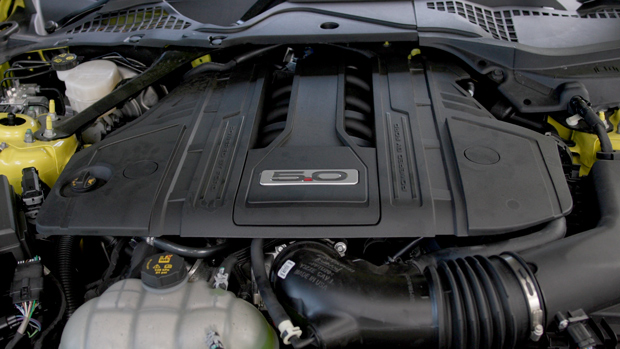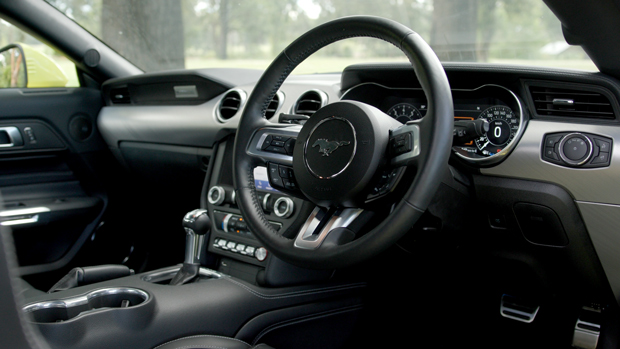
Ford Mustang GT Fastback review
How does the Ford Mustang GT Fastback drive?
At its international launch in Los Angeles in 2014, two things became immediately obvious about the sixth-generation Mustang. The first was its chassis balance - soaring far beyond the uncultured mess of the previous live-axled model - and the second was its all-round cohesion as a contemporary muscle car.
Further exploration of the car on bumpier, less well-cambered, less forgiving Australian roads revealed several dynamic flaws - namely muddy steering weighting and feel, plenty of vertical pitch in its suspension and fairly leisurely ESC intervention - but Mustang’s extensive 2018 facelift cured most of those ills, while introducing optional ‘MagneRide’ magnetic adaptive dampers.

Our test car is so equipped, which brings a much more level ride - pleasantly firm and sporty with the dampers in ‘Normal’ mode, which is somehow quite comfortable - and greater body control than before, meaning you can really fling this MY21.5 Mustang around in corners and it remains flat, poised and eager to go where it’s pointed.
Indeed, the Mustang GT is a much better driver’s car than people give it credit for. Combining excellent Michelin Pilot Sport 4S tyres with a limited-slip rear differential, multi-link independent rear suspension and decently sized brakes (380mm front discs with six-piston Brembo calipers, and 330mm ventilated rear discs), the latest Mustang packs a newfound level of finesse and sophistication that eluded the current generation at launch.
You can push really hard through corners and the Mustang hangs on gamely - aided by the hugely improved steering feel and precision of the facelifted car - and while the level of feedback to the driver’s fingertips is hardly Porsche-like, the Mustang still offers plenty of scope to adjust the oversteer angle of its rear end in the right environment.
Supporting the Mustang’s handling talent is a powertrain that’s been pumped to an impressive degree. With the 2018 update, the 5.0-litre naturally aspirated V8 received modifications to its capacity (up from 4951cc to 5038cc), fuel injection system, cylinder heads, crankshaft and connecting-rod design - resulting in a power jump to 339kW at 7000rpm (up 33kW) and 556Nm at 4600rpm (up 26Nm).

Tied to a new 10-speed torque converter automatic and with launch control engaged, Ford claims 0-100km/h in 4.3sec for the GT Fastback and 4.5sec for the GT Convertible, with the six-speed manual GT Fastback taking 4.6sec.
But the real talking point here is the V8’s exhaust system - a quad-outlet active set-up with four switchable modes (Quiet, Normal, Sport and Racetrack). Compared to the too-quiet previous model (even when fitted with an optional Ford Performance exhaust system), it’s an absolute riot - peppering the V8’s induction beef with a crackly bark that’s thunderously loud in the more outrageous modes.
Even in Quiet, there’s enough in-cabin rumble to keep you interested, while cruising around in Sport mode with 10 gear ratios filling the gaps delivers a constant stream of V8 delight.
Only under full acceleration does the 10-speed lose its lustre - dropping barely 500 revs between upshifts as it slays dragstrip times, rather than tapping into the V8’s muscular mid-range for the best acoustics. For this reason alone, I prefer the six-speed manual (now with twin-plate clutch and dual-mass flywheel for sweeter shifting).
Active-safety features and crash-safety ratings have never been the sixth-gen’ Mustang’s strong suit, though for varying reasons.

Head protection from side impacts for children sitting on booster seats in the rear is marginal - meaning the Mustang should very much be viewed as a two-plus-two (which it is), rather than a four-seater. And while the 2018 update introduced forward AEB with collision alert and pedestrian detection, lane-departure warning, lane-keep assist, auto high-beam and adaptive cruise control - lifting its ANCAP safety-assist score from 16 to 61 percent - the three-star Mustang remains mediocre when it comes crash safety.
Thanks to a lower bonnet line, its pedestrian-safety score has improved over the years but its adult crash-protection result remains a below-par 72 percent and its child-occupant protection is rated at just 32 percent. Best stick to the front seats then!
Link nội dung: https://pus.edu.vn/fastback-a61929.html